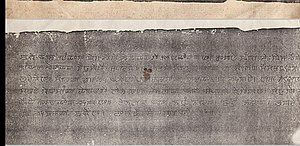TrangaBellam (talk | contribs) This is not relevant Tag: Visual edit |
TrangaBellam (talk | contribs) Remove reference which is not reliable. Tag: Visual edit |
||
| Line 15: | Line 15: | ||
==Contents== |
==Contents== |
||
===Origin of life and its spread according to Puya=== |
|||
According to [[Wakoklon Heelel Thilel Salai Amailon Pukok Puya]] and various [[Folk song|KhuNung Esei]], life was created on [[Mount Koubru|Mt. Koupalu]] and spread throughout the world from there.<ref>{{Cite web|last=Raghu|first=Ningthoujam|title=Awang Koubru Asuppa and Notion for Origin of Obliquity of Earth and Planets – KanglaOnline|url=https://kanglaonline.com/2018/09/awang-koubru-asuppa-and-notion-for-origin-of-obliquity-of-earth-and-planets/|access-date=24 October 2020|language=en-US}}</ref> |
|||
<blockquote> |
|||
* Awang Koupalu Asuppa |
|||
* Leima-Lai Khunda Ahaanba |
|||
* Nongthak-lei Mau lingliba |
|||
* Eelik Mapaan thariba |
|||
* O Lainingthou |
|||
</blockquote> |
|||
=== Religion === |
=== Religion === |
||
Revision as of 15:08, 23 May 2021
| Language | Meetei language |
|---|---|
| No. of books | more than 120[1] (Nongsamei Puya, Sanamahi Laihui, Numit Kappa, etc.[2]) |
The Puya, also known as Meetei Puya,[3] (Meitei: ꯄꯨꯌꯥ), from pu "ancestors" and ya or yaba "accept", are scriptures or documents, written by various Maichou(s)[4] from time to time. The Meetei Puyas deal with the genealogy, literature, history, royalties, administration, creation and cosmology, philosophy, poetry, religious beliefs, etc.[5][6]
Puya such as "Nongsamei Puya" records the details about Muslim settlement during the reign of King Khagemba.[7]
Contents
Religion
| Puya | |
|---|---|
 | |
| Information | |
| Religion | Sanamahism |
| Language | Meetei language |
Puya like Sanamahi laihui and Numit Kappa are Sanamahism religious texts written in the Meitei language using the Meitei script. They are a particular kind of old narrative which form a definite class in rituals, deities of Meitei[8] containing traditional lore of the Meitei people of Manipur.
List of Puyas
There are a number of archaic Puya books, including[citation needed]
- Watchetlon Pathup
- Sanamahi Laihui
- Wakoklon Heelel Thilen Salai Amailon Pukok Puya[9]
- Ponpilang
- Thiren Layat
- Numit Kappa
- Sakoklon
- Sakoklon Thilel
Related pages
- Lists of deities in Sanamahism
- Meitei literature
- Sanamahi creation myth
- Sanamahism
- Wakoklon Heelel Thilel Salai Amailon Pukok Puya
Sources
- http://e-pao.net/epSubPageExtractor.asp?src=manipur.Arts_and_Culture.Meetei_Puya_and_Meetei_tradition
- http://e-pao.net/epPageExtractor.asp?src=features.Translation_of_our_holy_book_Puya_in_English_A_visionary_approach_By_Samarjit_Kambam.html
- http://e-pao.net/epSubPageExtractor.asp?src=news_section.opinions.The_Puya_and_Cheitharol_Kumbaba
- http://e-pao.net/epSubPageExtractor.asp?src=news_section.opinions.Puya_Meithaba_The_Burning_of_Meitei_Sacred_Scripture_By_Madhu_Chandra
- http://e-pao.net/epSubPageExtractor.asp?src=leisure.Essays.Puya_Meithaba_The_Date_Controversy_By_Chabungbam_Amuba
Further reading
References
- ^ Rena, Laishram (2010) [2009]. The early meitei history (PDF) (pdf). New Delhi: AKANSHA PUBLISHING HOUSE (published 8 September 2010). pp. 1–12. ISBN 978-81-8370-163-1.
{{cite book}}:|archive-date=requires|archive-url=(help) - ^ Laishram, Sadhana. "Conservation and preservation of Manuscripts in Manipur" (PDF).
- ^ Rajshekhar, M. "In violence-scarred Manipur, ancient scrolls show why AFSPA will not work". Scroll.in. Retrieved 23 October 2020.
- ^ Devi, Dr Yumlembam Gopi. Glimpses of Manipuri Culture. Lulu.com. ISBN 978-0-359-72919-7.
- ^ Raghu, Ningthoujam. "Awang Koubru Asuppa and Notion for Origin of Obliquity of Earth and Planets – KanglaOnline". Retrieved 24 October 2020.
- ^ Paochel, article (9 November 2020). "Discovery of Kangleipak" (PDF).
{{cite web}}: CS1 maint: url-status (link) - ^ Renuka, Mangsatabam. "The Muslim Settlers in Manipur during the Reign of Meidingu Khagemba" (PDF).
- ^ Gourchandra, M. (1982). Sanamahi Laihui.
- ^ N. M. Meetei in: Arambam Noni, Kangujam Sanatomba (eds.), Colonialism and Resistance: Society and State in Manipur, Routledge, 2015, p. 223.
External links
- "KANGLEIPAK HISTORICAL & CULTURAL RESEARCH CENTRE - Hei-Ha - Epa Epu Gee Khongul Lirasi Salaicha Sing". Paochelsalaitaret.net. Retrieved 15 December 2018.